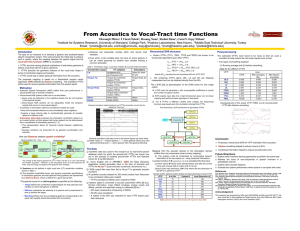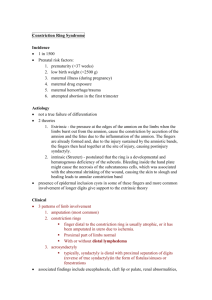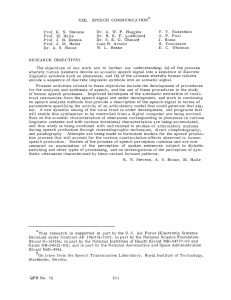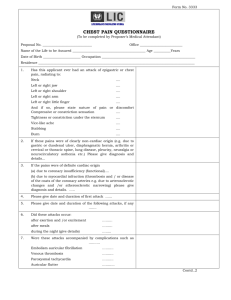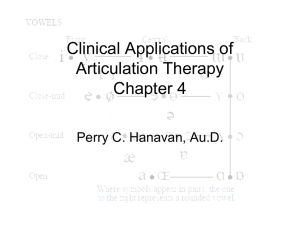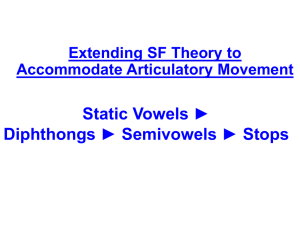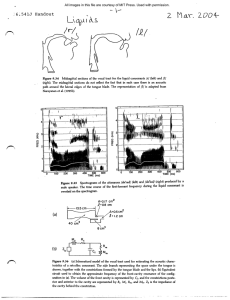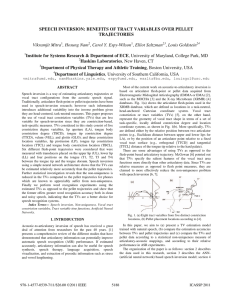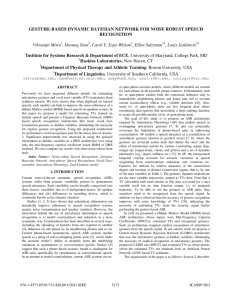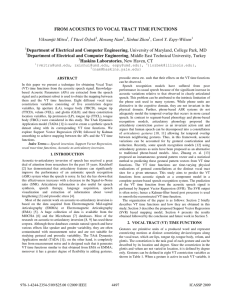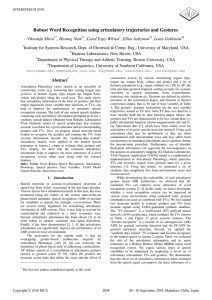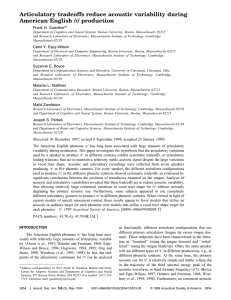Articulatory information for Robust Automatic Speech Recognition Speech Extraction Technology
advertisement
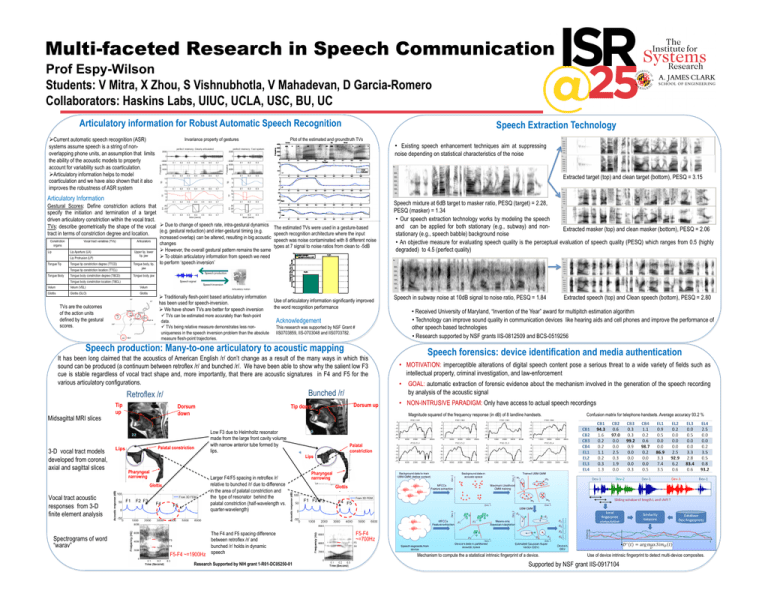
Multi-faceted Research in Speech Communication Prof Espy-Wilson Students: V Mitra, X Zhou, S Vishnubhotla, V Mahadevan, D Garcia-Romero Collaborators: Haskins Labs, UIUC, UCLA, USC, BU, UC Articulatory information for Robust Automatic Speech Recognition Current automatic speech recognition (ASR) systems assume speech is a string of nonoverlapping phone units, an assumption that limits the ability of the acoustic models to properly account for variability such as coarticulation. Articulatory information helps to model coarticulation and we have also shown that it also improves the robustness of ASR system Invariance property of gestures Speech Extraction Technology Plot of the estimated and groundtruth TVs noise depending on statistical characteristics of the noise Extracted target (top) and clean target (bottom), PESQ = 3.15 Articulatory Information Gestural Scores: Define constriction actions that specify the initiation and termination of a target driven articulatory constriction within the vocal tract. TVs: describe geometrically the shape of the vocal Due to change of speech rate, intra-gestural dynamics The estimated TVs were used in a gesture-based (e.g. gestural reduction) and inter-gestural timing (e.g. tract in terms of constriction degree and location. speech recognition architecture where the input Constriction organs Lip Vocal tract variables (TVs) Articulators Lip Aperture (LA) Upper lip, lower lip, jaw Lip Protrusion (LP) Tongue Tip Tongue tip constriction degree (TTCD) Tongue body, tip, jaw Tongue tip constriction location (TTCL) Tongue Body Tongue body constriction degree (TBCD) • Existing speech enhancement techniques aim at suppressing increased overlap) can be altered, resulting in big acoustic speech was noise contaminated with 8 different noise changes types at 7 signal to noise ratios from clean to -5dB However, the overall gestural pattern remains the same To obtain articulatory information from speech we need to perform ‘speech inversion’ Speech mixture at 6dB target to masker ratio, PESQ (target) = 2.28, PESQ (masker) = 1.34 • Our speech extraction technology works by modeling the speech and can be applied for both stationary (e.g., subway) and nonExtracted masker (top) and clean masker (bottom), PESQ = 2.06 stationary (e.g., speech babble) background noise • An objective measure for evaluating speech quality is the perceptual evaluation of speech quality (PESQ) which ranges from 0.5 (highly degraded) to 4.5 (perfect quality) Tongue body, jaw Tongue body constriction location (TBCL) Velum Velum (VEL) Velum Glottis Glottis (GLO) Glottis TVs are the outcomes of the action units defined by the gestural scores. Traditionally flesh-point based articulatory information has been used for speech-inversion. We have shown TVs are better for speech inversion Use of articulatory information significantly improved the word recognition performance TVs can be estimated more accurately than flesh-point data. TVs being relative measure demonstrates less nonuniqueness in the speech inversion problem than the absolute measure flesh-point trajectories. Acknowledgement This research was supported by NSF Grant # IIS0703859, IIS-0703048 and IIS0703782. Speech production: Many-to-one articulatory to acoustic mapping It has been long claimed that the acoustics of American English /r/ don’t change as a result of the many ways in which this sound can be produced (a continuum between retroflex /r/ and bunched /r/. We have been able to show why the salient low F3 cue is stable regardless of vocal tract shape and, more importantly, that there are acoustic signatures in F4 and F5 for the various articulatory configurations. Bunched /r/ Retroflex /r/ Midsagittal MRI slices 3-D vocal tract models developed from coronal, axial and sagittal slices Tip up Dorsum down Palatal constriction Lips Pharyngeal narrowing Vocal tract acoustic responses from 3-D finite element analysis F1 F2 F3 F4 Low F3 due to Helmholtz resonator made from the large front cavity volume with narrow anterior tube formed by lips. F5 Spectrograms of word “warav” F5-F4 ~=1900Hz The F4 and F5 spacing difference between retroflex /r/ and bunched /r/ holds in dynamic speech Research Supported by NIH grant 1-R01-DC05250-01 Extracted speech (top) and Clean speech (bottom), PESQ = 2.80 • Received University of Maryland, “Invention of the Year” award for multipitch estimation algorithm • Technology can improve sound quality in communication devices like hearing aids and cell phones and improve the performance of other speech based technologies • Research supported by NSF grants IIS-0812509 and BCS-0519256 Speech forensics: device identification and media authentication • MOTIVATION: imperceptible alterations of digital speech content pose a serious threat to a wide variety of fields such as intellectual property, criminal investigation, and law-enforcement • GOAL: automatic extraction of forensic evidence about the mechanism involved in the generation of the speech recording by analysis of the acoustic signal • NON-INTRUSIVE PARADIGM: Only have access to actual speech recordings Magnitude squared of the frequency response (in dB) of 8 landline handsets. Larger F4/F5 spacing in retroflex /r/ relative to bunched /r/ due to difference in the area of palatal constriction and the type of resonator behind the palatal constriction (half-wavelength vs. quarter-wavelength) Glottis Dorsum up Tip down Speech in subway noise at 10dB signal to noise ratio, PESQ = 1.84 Confusion matrix for telephone handsets. Average accuracy 93.2 % Palatal constriction Lips Pharyngeal narrowing Glottis F1 F2 F3 F4 F5 F5-F4 ~=700Hz Mechanism to compute the a statistical intrinsic fingerprint of a device. Use of device intrinsic fingerprint to detect multi-device composites. Supported by NSF grant IIS-0917104
